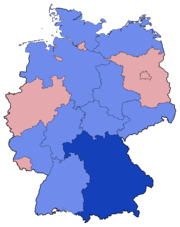1994 German federal election
| |||||||||||||||||||||||||||||||||||||||||||||||||||||||||||||||||||||||||||
All 672 seats in the Bundestag 337 seats were needed for a majority | |||||||||||||||||||||||||||||||||||||||||||||||||||||||||||||||||||||||||||
|---|---|---|---|---|---|---|---|---|---|---|---|---|---|---|---|---|---|---|---|---|---|---|---|---|---|---|---|---|---|---|---|---|---|---|---|---|---|---|---|---|---|---|---|---|---|---|---|---|---|---|---|---|---|---|---|---|---|---|---|---|---|---|---|---|---|---|---|---|---|---|---|---|---|---|---|
| Turnout | 79.0% (voting eligible)[1] | ||||||||||||||||||||||||||||||||||||||||||||||||||||||||||||||||||||||||||
| |||||||||||||||||||||||||||||||||||||||||||||||||||||||||||||||||||||||||||
 Party list election results by state: dark blue denotes states where CSU had the absolute majority of the votes; lighter blue denotes states where CDU had the plurality of votes; and pink denotes states where the SPD had the plurality of votes | |||||||||||||||||||||||||||||||||||||||||||||||||||||||||||||||||||||||||||
| |||||||||||||||||||||||||||||||||||||||||||||||||||||||||||||||||||||||||||
German federal elections took place on 16 October 1994, to elect members to the 13th Bundestag (parliament) of the Federal Republic of Germany.
Issues and campaign
The SPD let its members elect a candidate for Chancellor against Helmut Kohl. Rudolf Scharping, Minister-President of Rhineland-Palatinate, beat Gerhard Schröder and Heidemarie Wieczorek-Zeul in the SPD's internal election. Tension between Scharping and other SPD leaders such as Oskar Lafontaine and Gerhard Schröder hampered his campaign.
For the first time the Green party seemed to be willing to actually join a government in the event that a SPD – Green coalition had the majority.
Results
| This article is part of a series on the |
| Politics of Germany |
|---|
 |
Template:German federal election, 1994

| 294 | 47 | 252 | 49 | 30 |
| CDU/CSU | FDP | SPD | Grüne | PDS |
Post-election
The coalition between the CDU/CSU and the FDP was able to continue in power with Helmut Kohl as chancellor.
The PDS was able to gain four direct seats and was therefore eligible for full caucus status and proportional representation even though it remained below the 5% margin.
References
- ^ "Voter turnout by election year". Website of the Federal Returning Officer's Office. The Federal Returning Officer. Retrieved 7 November 2014.





